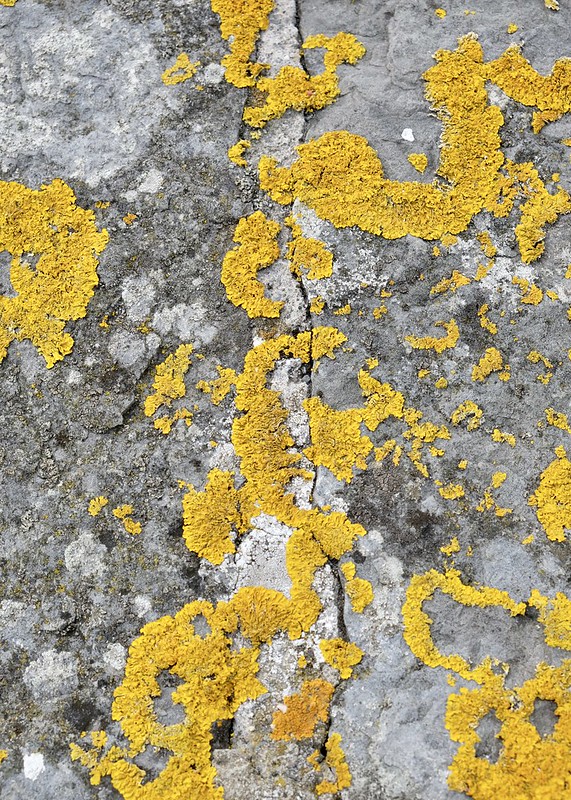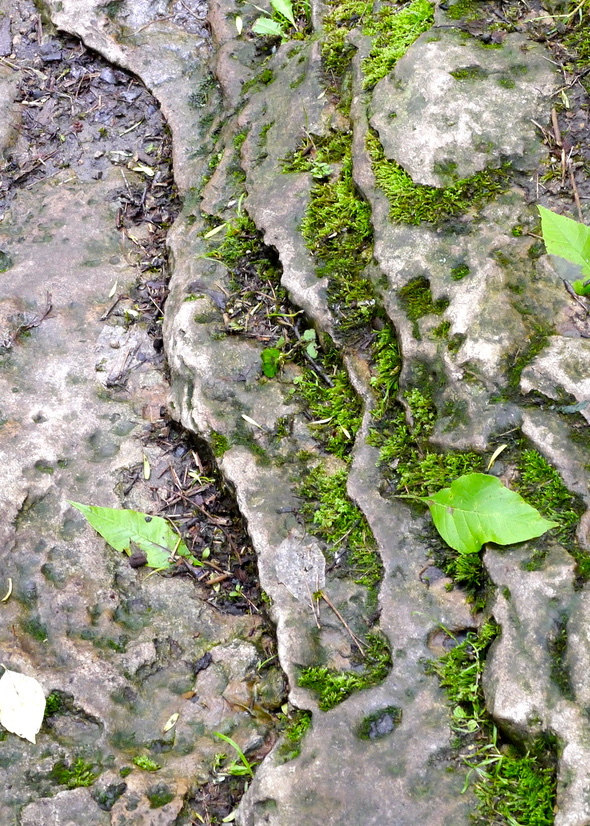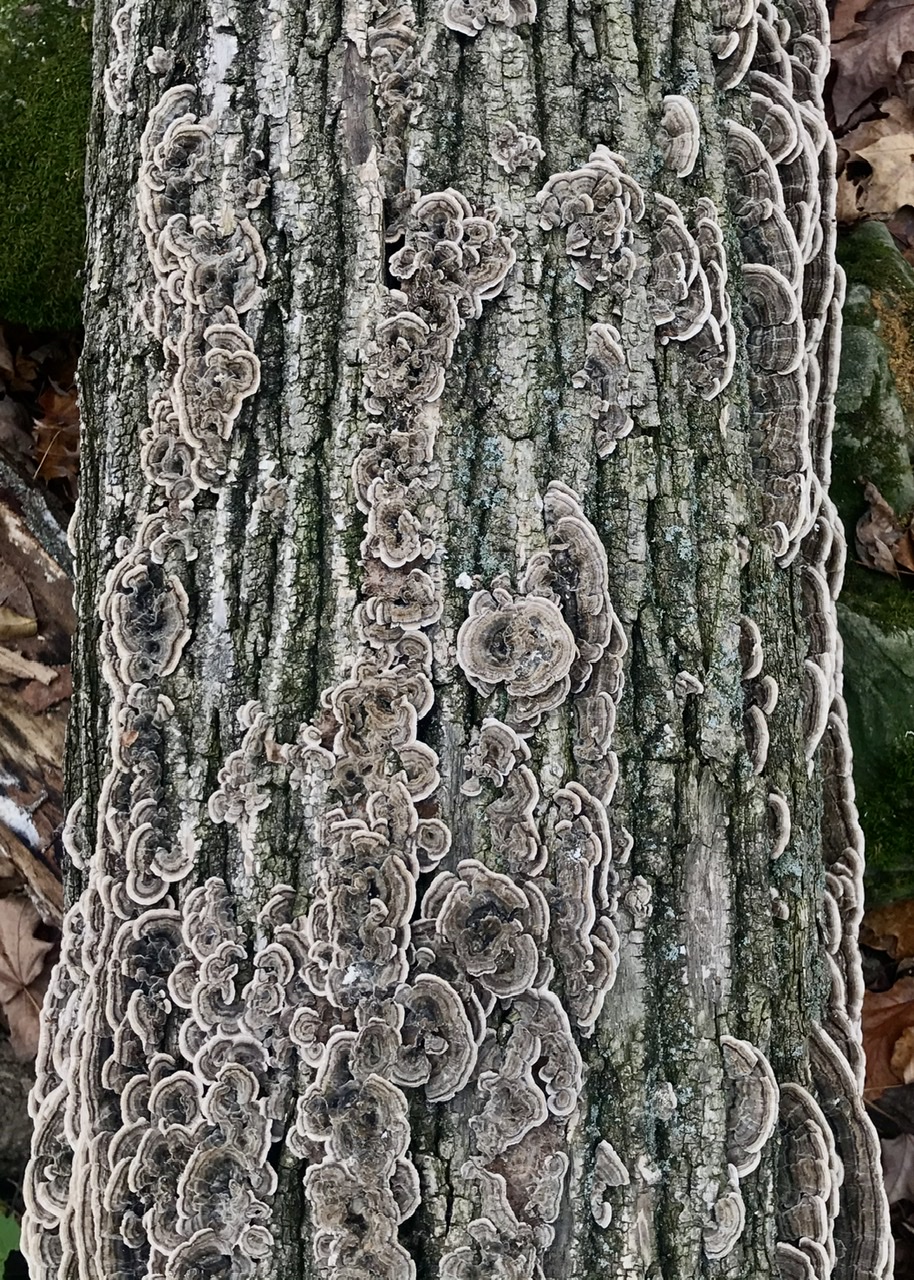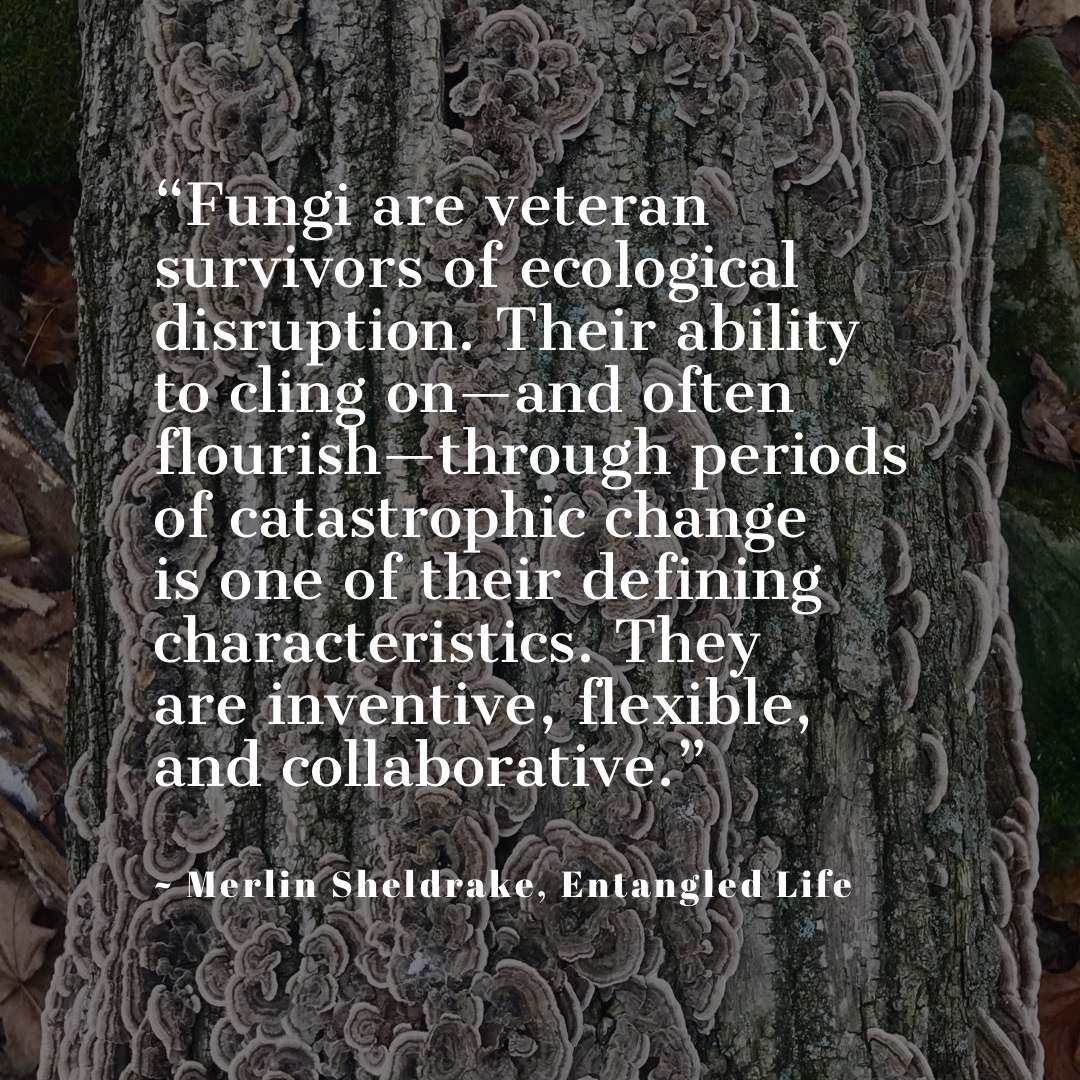


Three books I read in the last couple of years have me seeing fungi, moss, and lichens in a whole new way. What do these organisms have in common? Their smallness, their willingness to cooperate with other organisms, and their ability to adapt and survive. A couple of years ago, I read Robin Wall Kimmerer’s book, Braiding Sweetgrass, and wrote about lichens in this post, A Land of Reciprocity. This prompted me to read Kimmerer’s book, Gathering Moss. Kimmerer offer a contemplative lens in her writing. She weaves mind, body, and heart together as a scientist and member of the Potawatomi Nation, who loves the natural world. This past year, I read another fascinating book, Entangled Life by Merlin Sheldrake, all about the wonderful world of fungi. In this post, I’ll share a few things I learned from each of these books.
** Books mentioned have Amazon affiliate links, meaning I make a few cents if you purchase through my link. I only recommend books that I’ve read.
But first, a little elementary science as a refresher. Life is divided into two domains. Prokaryotes (organisms without a nucleus) include bacteria and archaea (single-celled microbes that resemble bacteria but which build their membranes differently). Eukaryotes, of which we humans are a part, include all other multicellular organisms with a nucleus, whether animal, plant, alga, or fungus.
In the 1960’s, American biologist Lynn Margulis proposed the revolutionary and controversial idea that symbiosis (when two different organisms live together and mutually benefit each other) played a central part in the evolution of life. Eukaryotes arose when a single-celled organism engulfed a bacterium, which continued to live symbiotically inside it. 500 million years ago, plants emerged from the water, with the help of fungi for their root systems. Lichens, which are a symbiosis between a fungus and an alga and/or cyanobacteria, were one of the first organisms to become established, making the soil where plants could thrive and take root. Mosses were one of those first plants. The relationship between plants and fungi gave rise to the biosphere we know today and fungi still weave their way among the roots of plants, providing nutrients and helping to prevent disease.
LICHENS
Braiding Sweetgrass by Robin Wall Kimmerer
I’ve long been fascinated by lichens and especially so since reading about them in Robin Wall Kimmerer’s book, Braiding Sweetgrass. This book is not all about lichens. More broadly it’s about Indigenous wisdom and specifically what plants can teach us. Kimmerer is a botanist and a member of the Citizen Potawatomi Nation. She’s also a poetic writer who sees plants and animals as kin, and as such, should be treated with respect and reverence. They have something to teach us about ways to live, particularly in terms of reciprocity. Here is a little of what she has to say about lichens.
“Lichens have no roots, no leaves, no flowers. They thrive in places where there is no soil and settle on granite. Lichens blur the definition of what it is to be an individual because they are not one being, but two: a fungus and an alga. Different as can be, yet they are joined in a symbiosis so close that their union becomes a whole new organism. It is like a marriage, where the whole is greater than the sum of the parts. The balance of giving and taking is dynamic, the roles of giver and taker shifting from moment to moment. Their shared lives benefit the whole ecosystem.” ~ Braiding Sweetgrass
Lichens are fascinating since they cannot be easily classified in a kingdom. While fungi can’t photosynthesize like plants, alga and cyanobacteria can, and therefore they provide a food source for the fungus. Cyanobacteria also provide nitrogen fixation. What do algae and cyanobacteria get in return? One, a protected environment, in the form of a type of shell, which absorbs ultraviolet light. Two, while the fungus (which is the dominant partner) can’t make its own food, it can dissolve and liberate minerals for its use and to share. Symbiosis enables the alga and the fungus to give and take in an exchange of sugar and minerals.
Lichens help the environment in key ways. Besides fixing nitrogen, they produce chemicals that can break down rocks and release minerals. This gradual decomposition leads to the formation of soils so that plants can thrive. Lichens also absorb pollution and their presence is an indicator of cleaner air. While visiting Ireland in 2019, we saw lots of lichen and our guide, Pius Murray, told us that this was a sign that the air was relatively clean. Some types of lichen can be a winter food source, for example, caribou forage for reindeer lichen. Researchers have studied this lichen relationship and found that when they tried to recreate the union in a lab, under ideal conditions, the two wanted nothing to do with each other. They were just fine on their own. So, they began to fiddle with the conditions.
”It was only when they severely curtailed resources, creating harsh and stressful conditions, that the two turned toward each other and begin to cooperate. When times are easy and there’s plenty to go around the individual species can go it alone. When times are harsh and life is tenuous, it takes a team sworn to reciprocity to “keep life going forward. In a world of scarcity, interconnection and mutual aid become critical for survival. So say the lichens.” ~ Braiding Sweetgrass
Lichens remind us that there is power and endurance in mutual cooperation, where the gifts of each is shared. Reciprocity has enabled lichens to flourish under the most stressful conditions. If you’re seeing lichens, it’s a sign that the air is pure and that’s a good thing to notice.
Source: Live Science and Braiding Sweetgrass
MOSSES
Gathering Moss by Robin Wall Kimmerer
After reading Braiding Sweetgrass, I wanted to read more of Kimmerer’s work. She wrote Gathering Moss in 2003 and it inspired Elizabeth Gilbert’s novel, The Signature of All Things, about an 19th century botanist named Alma Whittaker, who became a renowned expert in mosses. In Gathering Moss, Kimmerer brings attention to this mostly unnoticed element of the natural world. She explains how mosses live, how their lives are intertwined with other beings, and what they have to teach us, again in the context of indigenous ways of knowing.
”There is an ancient conversation going on between mosses and rocks, poetry to be sure. About light and shadow and the drift of continents. This is what has been called the dialectic of moss on stone – an interface of immensity and minuteness, of past and present, softness and hardness, stillness and vibrancy, yin and yang.” ~ Gathering Moss
Mosses (also called bryophytes) are non-vascular plants. They grow in wet environments, like rainforests, wetlands, and alpine ecosystems. Mosses produce spores, not seeds, and don’t grow flowers or have roots. They can be found on driveways and sidewalks, brick walls and other man-made structures, and on tree stumps in forests. Mosses celebrate smallness. They inhabit the boundary layer where other plants can’t grow. The reason that they’re so small is because they can’t transport water very well. When you come upon a spongy mat of moss, it’s made up of thousands of tiny individual mosses that group together to absorb and retain water. Mosses provide habitat and food for insects and other invertebrates. They help filter and hold water, which stabilizes the ground and they absorb CO2‚ from the atmosphere. Humans uses mosses for packing food, insulating houses, and even as fuel in the form of peat.
Kimmerer says that while we develop technology to help us see at the microscopic and macroscopic levels, we’re often blind to what is close at hand. This takes time and patience. A Cheyenne elder once told her that the best way to find something is not to look for it. Instead, look out of the corner of your eye, open to possibility. When something reveals itself to you in this way, it’s a sublime experience. Mosses invite us to see them in this way on a walk in the woods. When we look closer, whole new worlds are revealed. Kimmerer says that the role of mosses is to “clothe the rocks, purify the water, and soften the nests of birds.” She says that mosses are deeply bonded to and flourish only where they’re born. They give way more than they take, helping the entire ecosystem flourish.
”Learning to see mosses is more like listening than looking. A cursory glance will not do it. Mosses are the intertwined threads of a Beethoven quartet. We can see patterns emerge.” ~ Gathering Moss
Source: Basic Biology and Gathering Moss
FUNGI
Entangled Life: How Fungi Make Our Worlds, Change Our Minds & Shape Our Futures by Merlin Sheldrake and Fantastic Fungi by Louis Schwartzberg
Fungi came out of the sea more than 2 billion years ago and made life possible. They decompose material at the end of life and regenerate the soil so that new life can grow. There may be as many as 3.8 million species of fungi in the world, although scientists believe that 90% are not yet identified. A small percentage of these are yeasts and molds. Fungi are mostly hidden – inside of us and underground. The living body of fungi is called mycelium, made up of tiny thread-like filaments called hyphae. They can’t photosynthesize so they need to look for food elsewhere, absorbing nutrition from other organic substances. The hyphae secrete enzymes and acids that break down organic material into something they can absorb and this is how they’re nourished.
“They are eating rock, making soil, digesting pollutants, nourishing and killing plants, surviving in space, inducing visions, producing food, making medicines, manipulating animal behavior, and influencing the composition of the Earth’s atmosphere.” ~ Entangled Life
Mycorrhizal fungi partner with plant roots in a symbiotic exchange. Plants turn light and air into sugar through photosynthesis. By growing within plant roots, mycorrhizal fungi get access to this food energy: However, plants and fungi need more than energy; they need water and minerals from the ground, like phosphorous and nitrogen. Fungi provide this service.
Sheldrake says that mycorrhizal fungi are the roots of all subsequent life on land. They are so extensive that their mycelium makes up between a third and a half of the living mass of soils. In their relationship, plants engage with the light and air, while the fungi and plant roots engage with the ground. In Schwartzberg’s film, fungi is called “the digestive tract of the forest.”

When we think of fungi, we usually think of mushrooms, but these are just one type of fungi fruit. Mushrooms are good to eat, although some are poisonous to humans and others are medicinal drugs, whether psychedelic or healing. It was in 1928 that Alexander Fleming discovered that a mold produced a bacteria-killing chemical called penicillin. Penicillin is the first modern antibiotic and has saved millions of lives. Fungi can also cause serious infections and fungal diseases are increasing across the world due to unsustainable agricultural practices which reduce the ability of plants to form relationships with the beneficial fungi on which they depend.
The book and the film highlight the work of Paul Stamets, a mycologist who discovered four new species of psilocybin (psychedelic) mushrooms. One of Stamets’s “six ways that fungi can save the world” (TED talk) involves tweaking the biology of certain disease-causing fungi so they are able to bypass termites’ defenses and exterminate their colonies (this same fungus shows promise in eliminating populations of malarial mosquitoes). A material made from the outer layers of portabello mushrooms may be able to replace graphite in lithium batteries. The mycelium of some species is an effective skin substitute, and is used by surgeons to help wounds to heal. In the United States, a company called Ecovative Design is growing building materials out of mycelium. And, designer Stella McCartney is working with fungal leather grown using Ecovative’s methods. Finally, as decomposers, fungi can play a part in restoring toxic environments.
I personally can’t imagine what the world would be like without fungi. Lichens, mosses, and fungi are small and powerful. They can teach us a lot about survival, cooperation, and the interconnectedness of everything.
What do you know or love about lichens, mosses, or fungi?
Thank you for the wonderful pictures and post, Kim. I came across a beautiful display of fungi the other day and your post answered many of the queries I had about lichen and fungi. Kimmerer’s writings on the symbiosis and relationship of these organisms are not only poetic and fascinating; they are natural world lessons. Individuals giving more than they get, reciprocity, and coming together and responding to strife as a community, just to name a few. I will have to add Gathering Moss and Entangled Life to my ever-growing reading list. thank you!